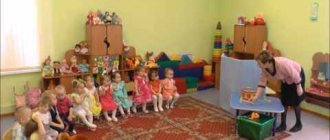The benefits of educational games
The games in question develop:
speech - children hear the speech of an adult and other preschoolers, therefore, their vocabulary is replenished
In addition, the guys answer questions, describe something, reason, therefore, the existing speech data are trained and improved;
thinking - preschoolers expand their knowledge about objects, phenomena, flora and fauna, learn new information, can compare existing experience with what they have received, train memory, logic, and mathematical abilities;
attention - children train listening skills and understanding what needs to be done, how to play the game correctly, therefore, they become more attentive, focused, and are able to regulate their actions;
physical qualities - the motor system develops, children become mobile, active, learn to control their movements, manage them, the child’s psyche is formed in terms of the ability to be active in life.
Balancer scales
According to our observations, this board game for children also becomes interesting after 2.5 years. And again, the players take turns throwing a different-colored die here. Having thrown out, for example, red, the player must put a red cylinder on the scales. In this case, you need to be very careful not to drop either yours or the previously installed cylinders. The loser, naturally, is the one whose entire structure collapses. The balance beam develops clarity of movements, accuracy and, of course, also teaches you to play by the rules: it teaches you to wait your turn, and it also gives the child the understanding that not only he can win.
By the way, we have come up with another version of this game: you can not only stack the cylinders on the scales, but also build a tower out of them, also guided by the color that appears on the die.
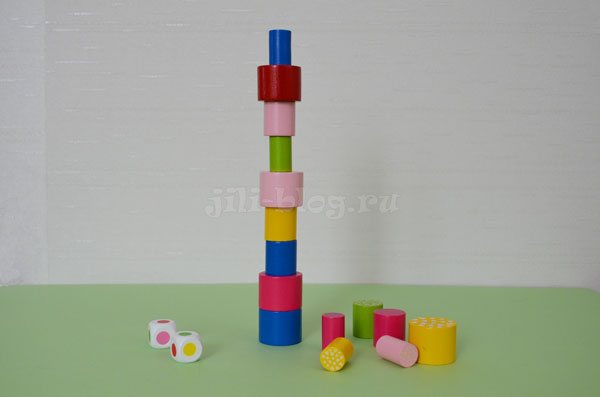
Ready-made walkers for babies
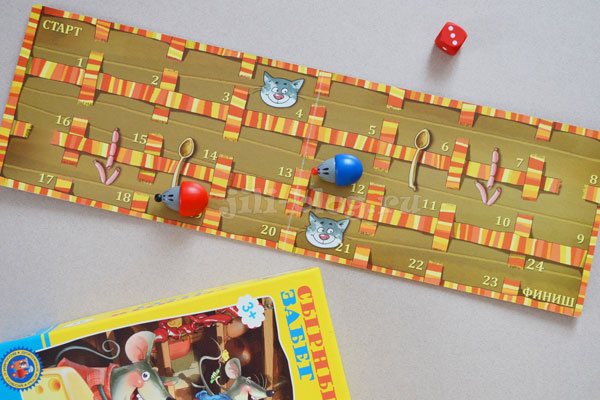
If we talk about ready-made options available in stores, then “Cheese Run” (Ozon, Labyrinth, My-shop) seemed the most suitable for the role of the first walker. There are very few cells here - only 24, so the child definitely won’t have time to get tired. In addition, the kit includes a special cube for beginning accountants - the number of dots on it does not exceed three.
What I didn’t like about this board game is that it is not entirely clear to a novice player which direction to go now, all the cells are stuck together and therefore the direction is not obvious to the child.
Another good option is walkers from Umka (Ozon, My-shop, KoroBoom). The games are also simple and accessible, but there are significantly more cells, and the cube has very small dots, which presents some difficulty for a child who is just learning to count the cells and dots on the cube. So the games are more suitable for children who are seeing walkers not for the first time.

Games with cubes and chips are not the only thing that can be offered to a 2-year-old child. Here are some equally interesting options for board games for kids:
Interesting for everyone
What you should pay attention to:
- age of the baby;
- interests;
- possibilities.
Why is it important? Because for some these will be exciting and developing projects, while for others they will be primitive, like completed material, which no one will like and which should not be allowed. Guys, do you know what is interesting to your little one personally? It would be good to take into account children's needs
Some people are crazy about trains, others need bunnies and monkeys. And others need to be taught how to count in a game or checked by traffic rules to see how much they know the rules, so that we remain calm when they go somewhere on their own
Guys, do you know what is interesting to your little one personally? It would be good to take children's needs into account as well. Some people are crazy about trains, others need bunnies and monkeys. And others need to be taught how to count in a game or checked by traffic rules to see how much they know the rules, so that we remain calm when they go somewhere on their own.
We are proud of our children! Their abilities are a reason for our little boast. And homemade strategy board games are a way to unlock a child’s potential and develop it.
Domino (Labyrinth, My-shop, KoroBoom)
Another classic game is dominoes. Naturally, at the first stage you will need a domino with pictures instead of dots. Most likely, the child will not yet be able to master the full version of the rules, but he will definitely be able to play the simplified version. We began to get acquainted with dominoes at the age of 1 year 9 months, then we simply built paths from it, simply combining pictures on dominoes. Later they began to take turns, and also differentiated the common pile of dominoes into “yours and mine.” I think now we can try to explain the full rules to my daughter (she is now 3 years old).

DIY toys for primary school children
Children of this age also need educational toys. Various board games are very suitable here. Again, there are a lot of them sold in stores, but there is one caveat. Firstly, they are expensive and there is a possibility that if you buy a toy. The child will use it only a couple of times and then abandon it. Therefore, it is better to make it yourself, especially since you can come up with the idea yourself.
One of the fairly simple and standard options is “tic-tac-toe”. Of course, the paper version with a pen and piece of paper does not require any costs at all. But, you must admit that such a toy made with your own hands can even become a gift. And to make it you will need a sheet of plywood or cardboard, which we paint and divide into squares and round chips, also cardboard. On some we draw a cross, on others a zero.
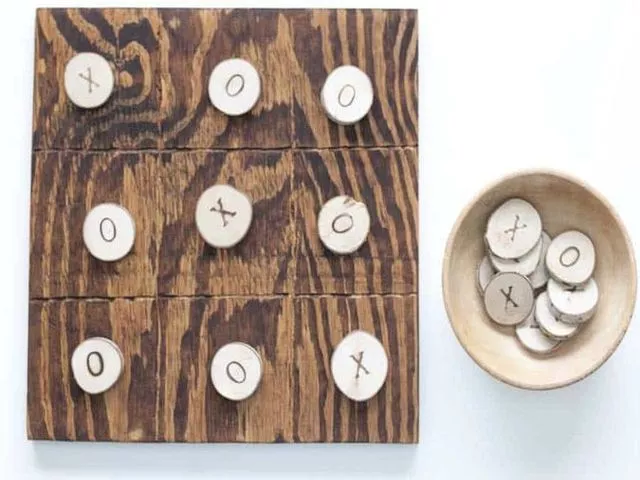
Both corks and flat buttons can be used for these purposes. The toy will turn out to be interesting, you can even take it with you to the dacha or on a trip.
As an option, instead of tiles with crosses and toes, you can make, for example, bees and ladybugs.
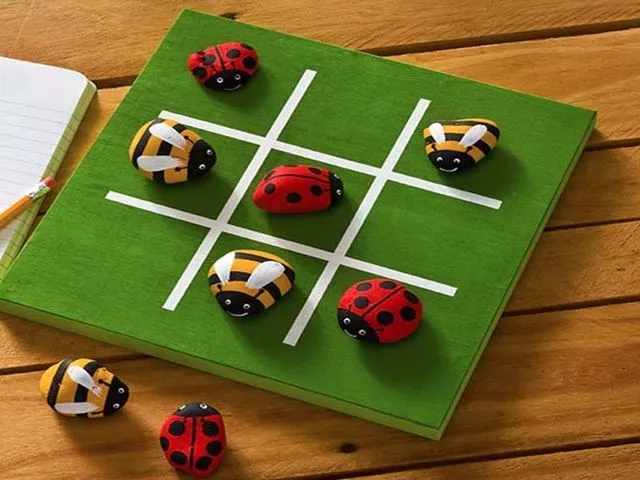
To spend useful time with children on trips, in addition to playing tic-tac-toe, you can make portable checkers. To do this, take an empty DVD box. Inside we attach a sheet of cardboard or any other material under the chessboard. Next, take flat buttons of the same size in two colors. You can choose any color, not necessarily black and white.
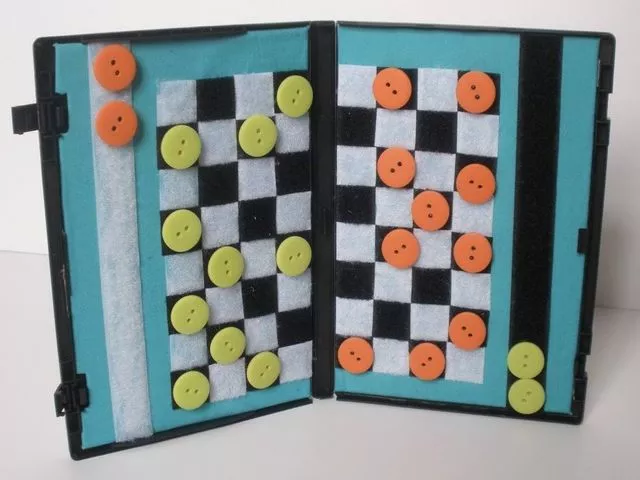
It turned out tasteful and original. With such a game, there is no shame in having a few “parties” with strangers.
If you want to play checkers like this at home, but want to have a larger field, well, take a large sheet of cardboard, paint it black and white checkered, take caps from plastic bottles in two colors and play.
The next type of creative game is extremely simple in its implementation. We will need a board, even a kitchen board, pins and colored rubber bands. Place pins on the board in the correct order. As a result, we get the so-called geoboard. Using rubber bands, you can build various geometric shapes on such a board.
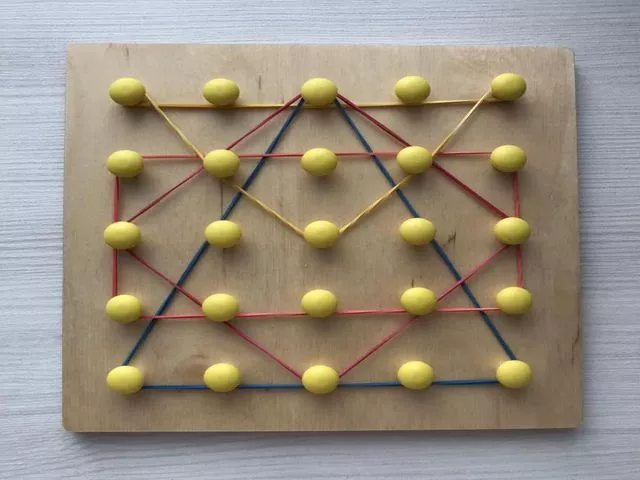
If you show your imagination, you can not only make squares and triangles, but even “draw” something. It turns out quite interesting, and most importantly, entertaining.
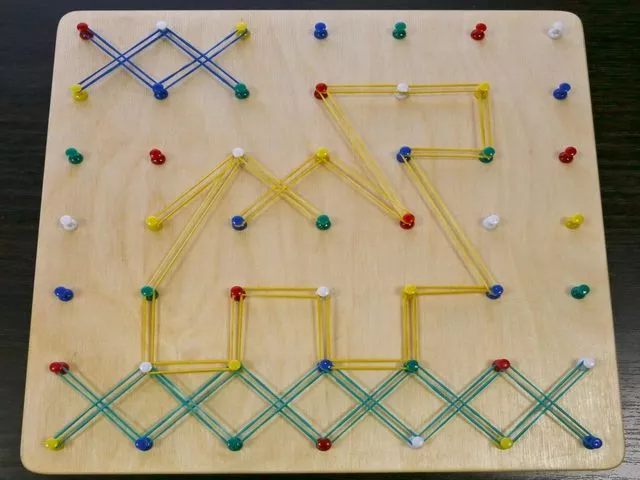
Back in the 20th century, pinball was a popular game. The field was marked with cells with numbers. The ball was shot onto the field using a spring and occupied a certain cell. Whoever scores more points wins. You can make this pinball yourself using cardboard and plastic bottle caps.

We have already talked about board games like football and hockey, but here I would like to present another interesting version of magnetic football. We take a lid from a shoe box and cut out gate holes on the sides of the opposite ends. In the corners we make legs from plastic tubes or all from the same cardboard. Then we cut out two small circles and glue a round magnet to them. We cut off two long narrow strips, to which we also glue a magnet. We are drawing out the football field. The game is ready.
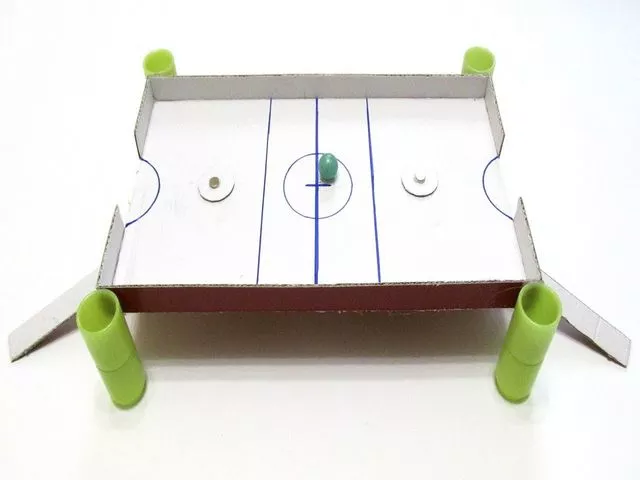
When you bring cardboard strips with magnets under the same magnetic circles and move the strips, the circles on the field will also move. Now we place the ball on the field and push it into the enemy’s goal.
Handy materials
Can I ask your opinion? Friends, what material do you prefer for crafts?
I will probably express the general point of view that this is the one with which it is easier or more interesting for you to create something at home.
And I will voice one more point. Sometimes I don't take new or valuable material. Even junk is used. Something that is kept by chance, or in anticipation that I can make something useful out of it. For example, corks from plastic bottles or wine, an old chessboard whose pieces are lost, buttons, pebbles, etc.
Well, when we have gathered everything: an understanding of what we have to construct with the children, for what purpose and for what purposes. We found out what materials we could use. We didn't forget the good mood. Now all that remains is to get down to business.
Walking game “Visiting the Bunny” (with dice and chips)
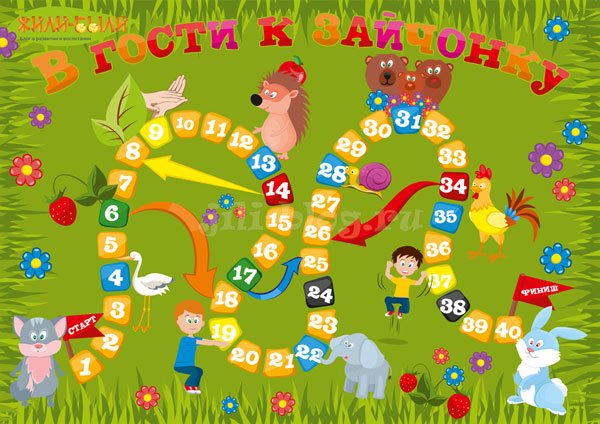
I made this walker for my daughter when she was 2.5 years old. It became a wonderful help for us in mastering counting, and it just helped us have an interesting time together; my daughter simply adored the game. I recommend that you take this game into your arsenal, as it is made just for the little ones. You can read more about our walker and download it HERE.
Tips for choosing
A board game is usually perceived as a pretty good gift, but (like any other product) it can be chosen either well or inappropriately.
Since it is given so that the child receives useful skills of his own free will, and not when he is forced, it is very important that the child likes the game, so that he becomes interested in it and begins to play regularly

There are some simple tips on how to achieve your goal:
For a child, play is a holiday. Even if she makes him think deeply, he himself still gets pleasure not from the process of solving a complex problem, as in chess, but from the surroundings. For this reason, a board game for a small child should be bright and beautiful, and also involve a certain legend, reminiscent of an interesting fairy tale.
“Colorful caterpillars” (My-shop, Labyrinth, KoroBoom)
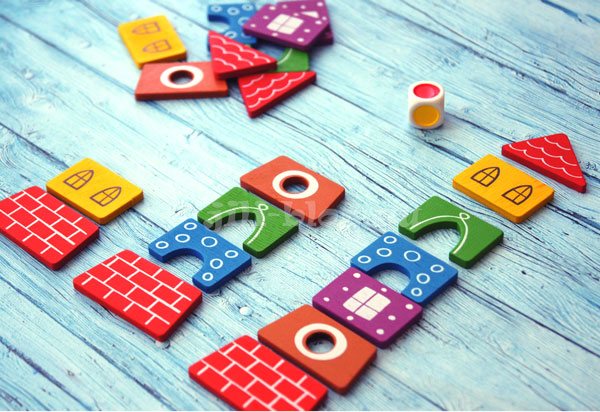
They have an excellent series of travel games that are compact and inexpensive. I would like to draw your attention to two games from this series - “Magic City” (pictured above) and “Colorful Caterpillars” (pictured below). Don't look at the fact that the box is marked 4+, it is clearly very overpriced. The games are perfect for children who are just starting to get acquainted with board games, because the rules here couldn’t be simpler.
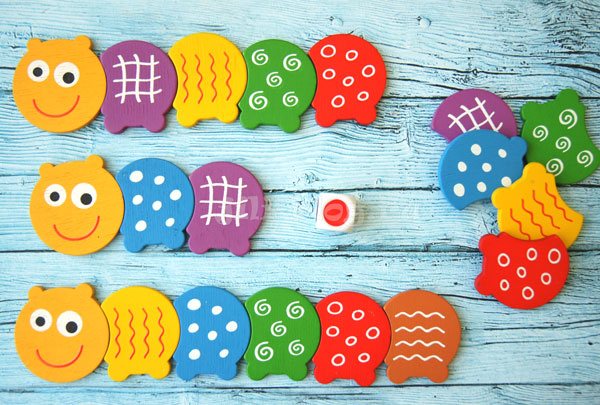
“Caterpillars” and “Magic City” are very similar in essence. And although the rules contain several variants of the game, the process boils down to approximately the same - participants take turns throwing a multi-colored die and placing a piece of the corresponding color on their tower/caterpillar. The one whose design is longer or reaches a certain detail wins. Everything is simple and easy - just enough to get used to acting according to the rules.



